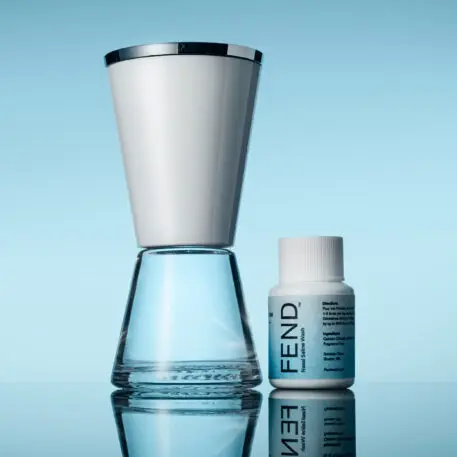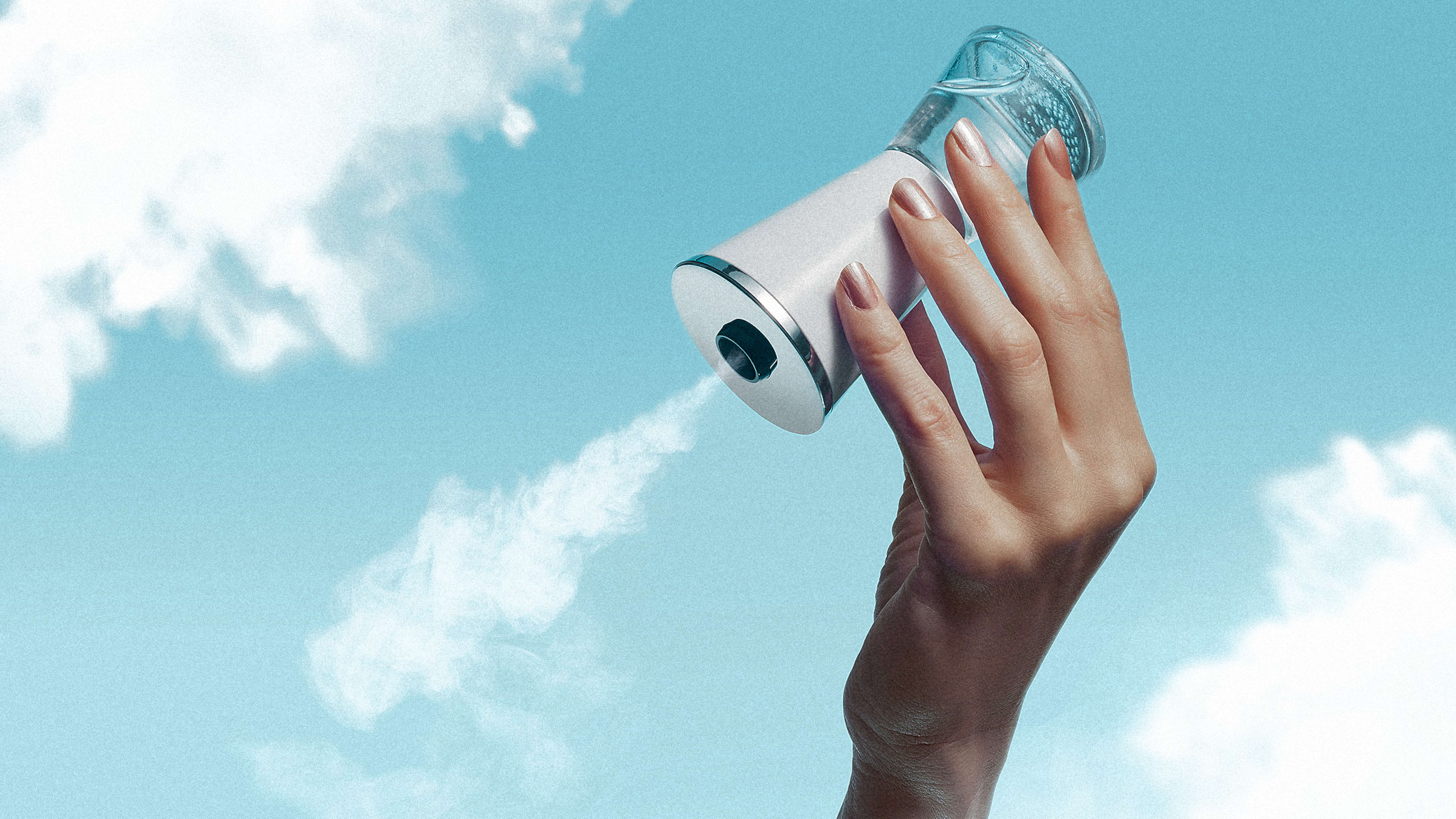Admittedly, I feel a little stupid. I’m staring at a diagram of a person with their head tilted back, aiming an hourglass device up their nose, and spraying a fine mist. The process looks every bit as graceful as using a neti pot or trimming nose hair.
But having talked to the Harvard scientist David Edwards who created this system, dubbed the FEND, I overcome my personal embarrassment. Because if it works as intended, this invention is groundbreaking. Edwards claims that if you take just two puffs with his device, you reduce your chance of exhaling COVID-19-filled droplets by 99% for six hours—which he validated over a series of studies with 92 people. In theory, it should make your own nose and throat more resistant to contracting COVID-19, too, by turning your throat into a sticky fly trap for the virus to keep it out of your lungs.
So I tilt my head back, and the device fires mist into the air. I breathe in deeply through my nose and—to my surprise, I actually do feel different within moments.

Wait, explain!
Let’s take a few steps back for a moment. David Edwards is a Harvard researcher who, in 2004, was studying how to protect people from one of the most diabolical, airborne biological weapons of our time: anthrax.
Inside the mucus that lines our nose, mouth, and trachea, there are proteins called mucins. And what he noticed was that, when someone inhales a simple saline solution, the salt makes mucins more effective. It actually calms the surface of the mucus in our body. Technically speaking, calcium chloride (the salt) has two positive charges. Mucus proteins are negatively charged. So the calcium glues two mucus proteins together at the molecular level. Inside your body, that reaction increases the surface viscoelasticity in your mucus, which means that tiny droplets are less likely to break away.
At the same time, that mucus serves as a protective layer inside your respiratory tract. It’s actually part of your natural defense system, meant to trap airborne particles before they enter your lungs. An airborne virus can hit this fluid lining like an animal stuck in tar, which Edwards believes prevents COVID-19 from penetrating to where it’s most dangerous: deep in your lungs.
As COVID-19 began to spread this year, Edwards wondered how his research with airborne diseases and aerosols might help. An entrepreneur, Edwards had developed a sprayer, which could vaporize droplets as a way of breathing food and alcohol in experimental dining. Working quickly, he sourced a pharmaceutical-grade saline and worked to retrofit his device and bring it to the health and wellness market.
He put this system on sale for $50 at launch. It includes two bottles of saline, which provide over 400 doses total, and the spray device itself, which never actually touches your nose, so it can be shared. Refills are cheap—$7.50 per bottle.
Using the FEND
The sprayer is shaped like an hourglass. Loaded with two small batteries and a very small bit of solution, it automatically vaporizes the saline when tilted. That saline isn’t just vaporized haphazardly, though—the droplets come out at exactly 10 microns in size. This is important. As Edwards explains, at 2 microns, they’d go all the way to your lungs like an inhaler. At 50 microns, they would never make it past your nose. But at 10 microns, the saline can work its way into your trachea where it sticks to your fluid lining and keeps viruses in check.
I understand the science at play, but standing, prepared to take my first whiff, I still feel like I’m being duped. My brain knows that this simple solution could, at least theoretically, help thwart the spread of COVID-19, or the seasonal flu, if enough of us use it. But my heart doubts the power of any medicine that doesn’t involve big pills or painful shots.
[Image: Fend]However, when the FEND sprays and I inhale, suddenly, my airways feel washed. The effect is refreshing in a way that even holding your nose up to a humidifier, or using a bottled saline spray, isn’t. The best analogy I can make is that my nose suddenly feels like a wet dog nose—in a good way!—and I’m immediately hooked. Through the dry nights of winter, I often sit up sniffing over and over like there’s sand up my nose. Right in that moment, I plan to FEND every night before bed to prevent this.
With my nasal ways fully moistened, I make my way to a big box hardware store to grab some essentials—I’m still wearing a mask, of course. With the COVID-19 positivity rate both locally and nationwide signaling a third wave, I snake through fellow customers who refuse to give me space. Honestly, I’m still as nervous as I’ve been for the past seven months I’ve spent mostly avoiding stores. But there is something reassuring, 40 minutes after I’ve FENDed, that I still feel the chilly sensation in my nose.
One problem, I realize, is that while people can see my mask, the application of FEND is entirely invisible. They don’t know I’m taking additional steps to protect them and myself.
Edwards doesn’t necessarily imagine that my use case is typical, however. He sees FEND as something that might be mandated at workplaces and restaurants. If you plan to enter a space, you might need to take a FEND spritzer, first, much like your temperature could be checked with an infrared thermometer. On one hand, FEND is so cheap, quick, and painless, why not mandate its use everywhere while we await a vaccine? On the other hand, I also wonder if solutions like FEND, while measurably helpful, might lure people into a false sense of security—the same false sense of security we’ve seen since people have started wearing masks but are otherwise living their lives without social distancing.
As for me, standing in this big box store, I feel like I’ve done everything I can to be a good citizen in the COVID-19 era—to keep others safe in case I’m sick, and keep my family safe in case others are sick. And while I still can’t know for sure that it’s actually making any difference, I decide that I’m willing to place a little faith in science—and easier breathing.
Recognize your brand’s excellence by applying to this year’s Brands That Matter Awards before the early-rate deadline, May 3.
